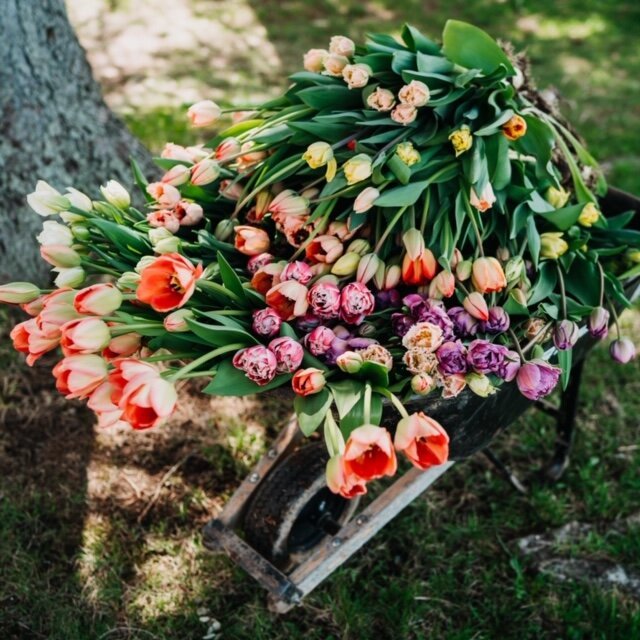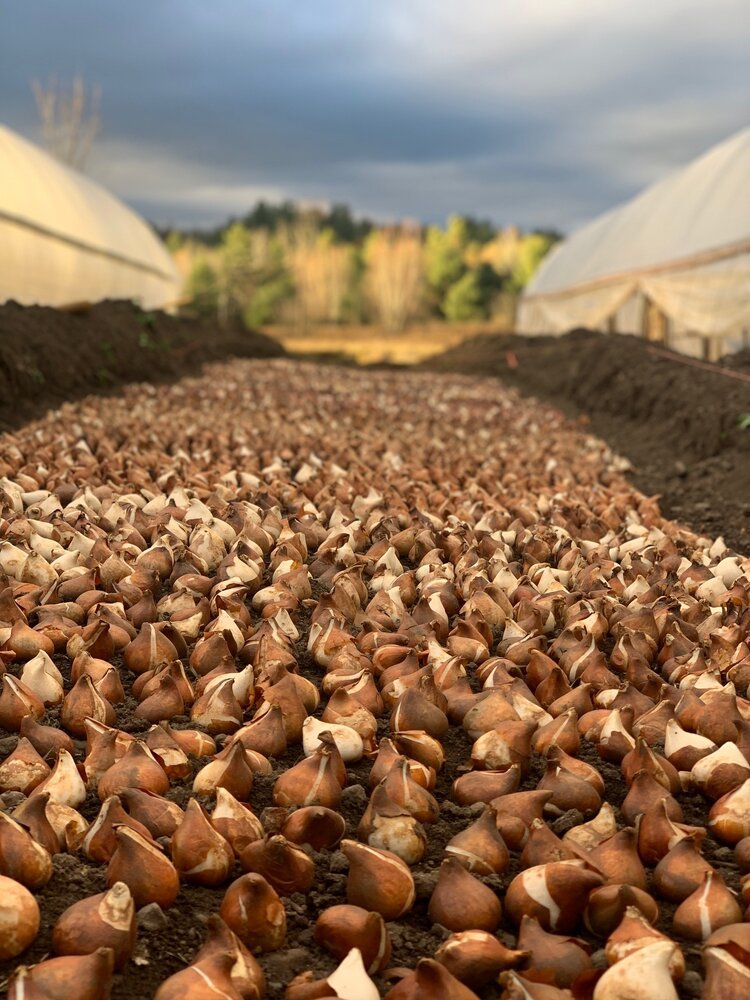contact dermatitis in tulip farmers
If you’ve been following along with my flower farming experiences the last few years you know of my love for tulips. A fascination with understanding how they work and how to make them a mainstay of our cold, Adirondack climate has been a focus of my personal and business interests the last few years. And I’ve only ever received love from my relationship with the beauties. Until…this fall.
We harvest tulips hourly in the spring when the sun warms the greenhouses and they explode with blooms.
The pressures of the pandemic on our farming schedule and delays in international shipping of bulbs undeniably led to a back log in our tulip planting plans. I had an extra helper back on staff by that time, but we were still scrambling to plant bulbs. I did what I normally do— hopped in the (literal) trenches and planted away. Instagram and Facebook friends reveled at the photos of thousands of bulbs placed out carefully—like eggs in a carton- close, but not touching.
Fall planting of field-grown tulip bulbs. Photo by Linda D’Arco
But behind all the magic of bulb season, something started to afflict my hands. At first, it presented as dryness and itching in the areas where the fingernail meets the skin. It sort of felt like that raw feeling after you’ve just cut your nails too short. There was some redness. I thought it might have to do with the planting medium we were using for the crated planted bulbs. Then I thought it might be the little papery coats of the tulips somehow cutting me under the nails— like a ton of little paper cuts. That’s how I remember it feeling.
One evening, after dinner, the symptoms turned from itching to intense burning and the feeling spread. It felt like all of my fingertips and the tissue beneath the nails were on fire. I just kept staring at them. There was no heat emanating from them like you’d expect from infection. To everyone else in my family, they looked pretty normal. But. THEY WERE BURNING ME. We tried a number of things— cool water and ice (this felt good), aloe vera gel (also felt good), ibuprofen, and Claritin. It was clear to me that my body was in attack mode, and it got to the point where I considered asking my husband to drive me to get help. It was SO painful. Eventually, we think the Claritin kicked in and the pain started to subside.
I found an article about contact dermatitis (allergy/immune response) amongst tulip farmers. It is also sometimes referred to as ‘Tulip Fingers’. This diagnosis seems to fit the bill. If you handle a lot of tulip bulbs, I highly recommend taking a look at this piece. It explains the chemistry behind the allergy, other symptoms, and the reasons tulips produce the fungal fighting tuliposides and tulipalins that can cause a reaction in humans. It is also re-assuring— the casual home gardener who is not coming into contact regularly with tulip bulbs need not worry.
What next?— I sensibly wore gloves or took on other projects during the rest of tulip planting season. My symptoms subsided.
Not surprisingly, as soon as our first hydroponic tulips started blooming in our indoor grow space and I was handling the plants and bulbs again (I was excited to see them and forgot my gloves) the symptoms returned, along with peeling of the top layers of skin on the tips of my thumbs and index fingers and itchy red bumps anywhere I’d inadvertently allowed tulip bulbs or roots to touch my skin. It happened faster this time. But I also caught the symptoms early and resolved to keep a pair of nitrile gloves on hand at all times. I don’t plan to abandon tulips at all. My love for them holds true, but my respect for them has certainly grown!
Note: Tulips are not the only flowers that can cause this kind of reaction. Some other common species are chrysanthemums and alstroemeria.
Have a question or comment about immune responses to flowers and plants? Please share a comment, and I’ll try to get right back to you. As always- your doctor is the best person to consult if you are worried about your health. This post is just about my experience and offers no medical advice.
Best,
All photos (except noted) by Due West Photography.



